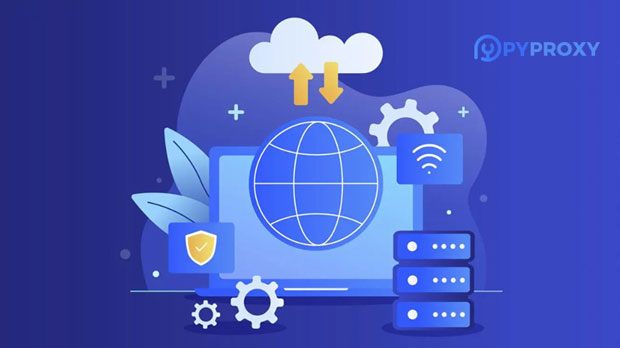What is SockS5 residential proxy server and how does it differ from traditional proxies?
With the increasing demand for network privacy and security, proxy server has become a tool to protect user identity, bypass regional restrictions and improve Internet access security. Proxy servers are generally divided into various types, among which the difference between " residential proxy servers" and traditional proxies is particularly prominent. As one of the protocols, socks5 proxy is increasingly favored by users in the global network environment due to its unique advantagesA residential proxy server is a server that uses the IP address assigned by an Internet service provider (ISP) to ordinary residential users as a proxy access point. These IP addresses are usually more difficult to detect because they look like the IP addresses of ordinary home users rather than the IP addresses of data center servers. Therefore, residential agents are often used to conceal users' true identities, bypass IP blocking, and perform web crawling or data scraping tasksSockS5 proxy is a more universal and flexible proxy protocol. Compared to other proxy protocols such as HTTP proxy, SockS5 can handle more types of traffic, including HTTP, HTTPS, FTP, etc. By providing stronger protocol support and higher anonymity, Socks5 proxy is widely used in various scenarios that require high anonymityThis article will explore in detail the differences between residential proxy servers and traditional proxies, analyze their respective advantages and disadvantages, and introduce the unique features of the SockS5 protocol. Through these analyses, users can better understand when to use residential proxy servers and how to choose appropriate proxy protocols to meet specific needsBasic concepts of residential agency and traditional agency Before further comparing the differences between residential agents and traditional agents, it is necessary to first clarify their basic concepts1. Traditional proxy serverTraditional proxies typically refer to data center based proxy servers located in large data centers, with IP addresses typically assigned by cloud service providers or hosting service providers. The main advantages of such agents are their affordability and efficiency, and they are typically used for large-scale tasks such as data collection, SEO analysis, and ad clicks2. Residential proxy serverThe residential proxy server uses IP addresses from the home network of ordinary users. These IP addresses are allocated by Internet service providers (ISPs) and are generally considered as "legal" residential IP addresses. Because these IP addresses are used by ordinary households, they are more difficult to detect as proxy addresses and are typically used for tasks with higher privacy and security requirements, such as accessing blocked websites, bypassing regional restrictions, etcThe main differences between residential agents and traditional agentsAfter understanding the basic definitions of both, the following will delve into the main differences between residential agents and traditional agents. Their differences can be compared from the following aspects:1. Differences in IP types and sourcesResidential agents use the IP addresses of ordinary households or individual users, while traditional agents typically use IP addresses provided by data centers or server hosting centers. Due to the legality and regional nature of residential IP addresses, using residential agents is not easily detected by websites or services. Traditional agents are easily identified and blocked due to their concentration in data centers2. Anonymity and anonymityResidential agents perform better than traditional agents in terms of anonymity and anonymity. Due to the lack of any significant "proxy" features in residential IP addresses, it is difficult to track or block the identity of visitors when using residential proxies. On the contrary, the data center IP used by traditional proxies may be easily recognized by major websites or firewalls and may be added to blacklists, resulting in restricted access3. Cost differenceThe cost of residential agents is relatively high because their IP addresses are sourced from ordinary users' home networks, and these IP addresses need to be purchased and managed through ISPs. On the other hand, traditional agents have lower costs because they are mostly provided by data centers and have a large quantity, typically used for a large number of web crawlers and automated tasks4. Network speed and stabilityTraditional proxies typically provide higher bandwidth and more stable connections, especially in data center network environments. Residential agents may be affected by network bandwidth limitations of household users, resulting in slower access speeds. In addition, the stability of residential agents is sometimes not as good as traditional agents, as residential networks may be subject to more interference or limitations5. Usage scenarios and applicabilityResidential agents are more suitable for scenarios that require higher anonymity and lower recognition risks, such as bypassing regional blockades, conducting web crawling, and protecting privacy. It is suitable for websites or applications that are blocked or require high anonymity. Traditional proxies are more suitable for tasks such as large-scale data scraping and SEO optimization, especially in situations where anonymity requirements are relatively lowCharacteristics and advantages of Socks5 proxy protocolSockS5 is currently one of the most widely used proxy protocols, which has significant advantages over other proxy protocols such as HTTP or HTTPS proxies. SockS5 not only supports multiple protocols such as TCP, UDP, etc., but its flexibility and compatibility make it suitable for various network applications. Here are several main features and advantages of SockS5:1. Higher protocol supportThe SockS5 protocol is different from traditional HTTP proxies. It not only supports HTTP traffic, but also supports various types of traffic such as FTP and SMTP, making SockS5 applicable to more diverse network scenarios2. Stronger privacy protectionSockS5 does not change the content of the original request when processing network requests, therefore, when using a SockS5 proxy, users' privacy and security are better protected. Compared to HTTP proxies, SockS5 performs lower level processing on user packets, making user identity information more concealed3. No need to modify request dataThe forwarding of data by Socks5 proxy does not require modification of content, making Socks5 suitable for various more complex applications such as P2P file sharing, online gaming, etc., ensuring the integrity and security of the original request data4. Higher connection success rateCompared with traditional proxies, the SockS5 protocol has a higher success rate and stability for applications that require long-term stable connections, such as video streaming, gaming, etc. Because it can effectively handle different types of network traffic, reducing the probability of connection failure5. More flexible access controlSockS5 supports more flexible authentication mechanisms, allowing users to set usernames and passwords on proxy servers, further increasing the security of proxy usage. This mechanism is particularly suitable for enterprise or individual users who require advanced access controlHow to choose a suitable proxy serverWhen choosing a proxy server, users need to decide whether to use a residential proxy or a traditional proxy, or whether to use the SockS5 protocol based on their actual needs. Here are some considerations to help users choose the most suitable proxy solution:1. Requirement analysis-If users need high anonymity, bypass regional restrictions, access blocked content, or perform tasks involving high privacy protection, residential agents are a more suitable choice-If the user's goal is to perform large-scale data scraping, SEO analysis, and other tasks with low requirements for anonymity, traditional agents are more economical and practical 2. Cost considerations-The cost of residential agency is usually high and suitable for high-value application scenarios. Traditional proxies have cost advantages and are suitable for users with limited budgets but still requiring a large number of proxy access3. Performance and stability-For users who require high network speed and stability, traditional proxies are usually a more ideal choice due to their stable server network and higher bandwidth-If the task does not require high bandwidth and can tolerate certain speed fluctuations, residential agents can provide stronger concealment4. Security and Privacy Protection-For tasks that require safeguarding user privacy and data security, using the Socks5 proxy protocol is usually the best choice, especially when performing P2P, video streaming, online gaming, and other operations. The Socks5 protocol can provide stronger securityConclusionThe difference between residential proxy servers and traditional proxies is very obvious, as they are suitable for different scenarios and needs. Residential agents have become the preferred choice for protecting user privacy due to their high concealment and stronger ability to bypass blockades. Traditional agents have advantages in cost and stability, making them suitable for tasks such as large-scale data scraping. As a flexible and powerful proxy protocol, Socks5 protocol can meet more complex application requirements, especially in improving anonymity and ensuring connection stabilityWhen choosing an agent, users should comprehensively consider their own needs, budget, and usage scenarios, and choose the most suitable agent solution to maximize efficiency, reduce risks, and ensure security
2024-12-17
























































